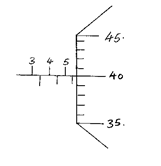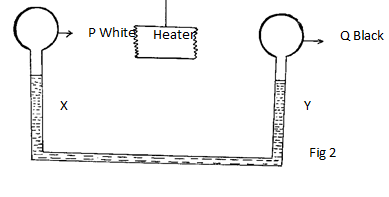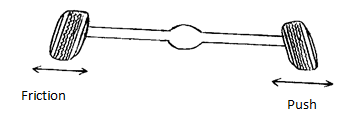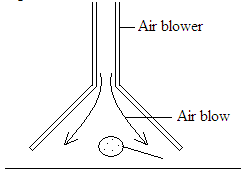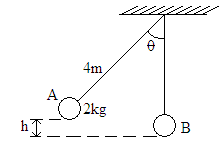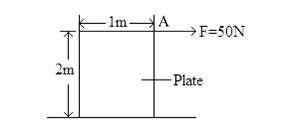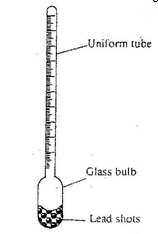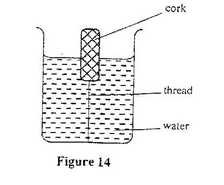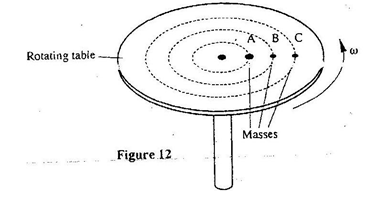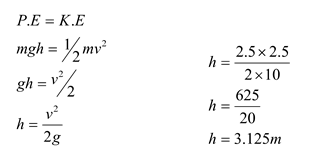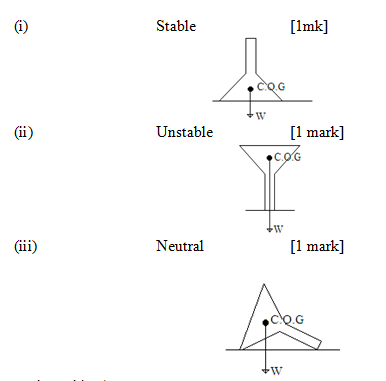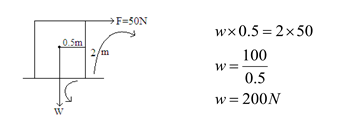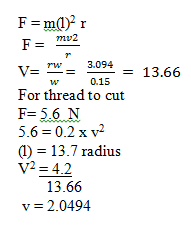INSTRUCTIONS TO CANDIDATES
- This paper consists of Two sections A and B
- Answer ALL the questions in sections A and B
- All working MUST be clearly shown
- Mathematical tables and Electronic calculators may be used.
Take: Acceleration due to gravity g = 10ms-2
Density of water= 1000kgm-3
Answer ALL questions in this section in the spaces provided.
- Figure 1 shows a micrometer with a negative error of 0.02 mm, used to measure the diameter of a ball bearing.
Record the diameter of the ball (2mks)
- Explain the washing effects of detergents of soap and why detergents in warm water washes greasy clothes even better (2mks)
- State the reasons why concrete beam reinforced with steel does not crack when subjected to changes in temperature (1mk)
- The diagram below shows two bulbs P and Q painted white and black
Explain what happens when the heater is turned on? (2mks)
- The figure below shows the path taken by a fluid flowing from region A to C
Explain the looping at B (1mk)
- A car of mass 1000kg traveling at 36km/h is brought to rest over a distance of 20m. Find
- The acceleration (2mks)
- The breaking force in Newton’s (1mk)
- A carbon dioxide cylinder contains 300cm3 of gas at a pressure of 2.40 x 107 Atmosphere pressure is 1.01 x 105 pa. Calculate the volume of the gas at atmospheric pressure (2mks)
- The figure below shows a cambered wheels
What is the advantage of these? (1mk)
- The diagram below shows a water tank of height h?
What is the relationship between the velocity V of the water jet and the height h (1mk)
- A cylindrical container has a base area of 150cm2 and is filled with water to a depth of 25cm. Find the pressure due to the column of thewater on the base. (2mks)
- The figure below shows a pith ball being lifted in to a funnel end of a blower.
Explain this observation (2 mks)
- A resultant force F acts on a body of ‘M’ causing an acceleration of A1 on the body. When the same force acts on a body of mass 2m, it causes an acceleration of A2. Express A2 in terms of A1. (3 mks)
- A metal ball suspended vertically with a wire is displaced through an angle as shown in the diagram below. The body is released from A and swings back to ‘B’.
Given that the maximum velocity at the lowest point B is 2.5 m/s. Find the height h from which the ball is released (3 mks)
SECTION B (55 Marks)
Answer ALL questions in this section in the spaces provided.
-
- Use simple sketches to show the three states of equilibrium.
Name the states. (3 mks) - Define center of gravity of a body. (1 mk
- State two factors affecting stability of body (2 mks)
- The figure below shows a metal plate 2 m long, 1m wide and negligible thickness. A horizontal force of 50 N applied at point ‘A’ Just makes the plate tilt.
Calculate the weight of the plate. (3 mks)
- Use simple sketches to show the three states of equilibrium.
-
- State what is meant by the term ‘specific latent heat of vaporization’ (1mk)
- In an experiment to determine the specific latent heat of vaporization of water, steam at 1000C was passed into water contained in a well-lagged copper calorimeter. The following measurements were made;
Mass of calorimeter 50g
Initial mass of water 70g
Final mass of calorimeter + water + condensed steam = 23g
Final temperature of mixture = 30g
(Specific heat capacity of water = 4,200 Jkg-1 K-1 specific heat capacity for copper = 390 Jkg-1 K-1)- Determine the:
- Mass of condensed steam (2mks)
- Heat gained by the calorimeter and water (3mks)
- Given that L is the specific latent heat of vaporization of steam,
- write an expression for the heat given out steam. (1mk)
- Determine the value of L. (3mks)
- Determine the:
-
- State the Archimedes principle (1mk)
- State the law of floating (1 mark)
- The figure below shows a simple hydrometer
- State the purpose of the lead shots in the glass bulb (1 mark)
- How would the hydrometer be made more sensitive? (1 mark)
- Describe how the hydrometer is calibrated to measure relative density (2mks)
- Figure 14 shows a cork floating on water and held to the bottom of the beaker by a thin thread.
- Name all the forces acting on the cork (3marks)
- Describe how each of the forces mentioned in (i) above changes when water is added into the beaker until it fills up. (3 marks)
-
- State what is meant by centripetal acceleration (1mk)
- The figure below shows masses, A, B and C placed at different points on a rotating table. The angular velocity, ù, of the table can be varied.
- State two factors that determine whether a particular mass slides off the table or not ( 2 marks)
- It is found that the masses slide off at angular velocities ùA, ùB, and ùC Arrange the values of ùA, ùB, ùC in decreasing order. (1mk)
- A block of mass 200g is placed on a frictionless rotating table while fixed to the centre of the table by a thin thread. The distance from the centre of the table to the block is 15 cm. If the maximum tension the thread can withstand is 5.6N. Determine the maximum angular velocity the table can attain before the thread cuts.(4 mks)
- A turntable of radius 8cm is rotating at 33 revolutions per second. Determine the linear speed of a point on the circumference of the turntable. (4 marks)
- Define angular velocity. (1 Mark)

MARKING SCHEME
- 5
+ 0.40
5.90 mm ✔
+0.02
5.92mm ✔
- Detergents acts as impurity breaking ✔ surface tension while a combination of the two increases breaking surface tension ✔ of dirt
- They expand uniformly or almost have equal linear expansivity ✔
- When the heater ✔ is switched on bulb Q absorbs more heat than bulb P thus causing the air in it to expand and push the water level y downwards ✔ while level x rises
- Because of turbulence caused by✔ a sudden change in depth and decrease in velocity of air hence the looping
-
- V2= u2 + 2as
V = 0
U = 36 km/h = 36 x 1000 = 10 m/s
60 x 60
02 = 102 + 2 x a x 20 ✔
a = -102
2 x 20
= -2.5 m/s2✔ - F = breaking force = ma
= 2.5 x 1000
= 2500 N ✔
- V2= u2 + 2as
- P1V1 = P2V2
V2 = 2.40 x 107 x 300✔
1.01 x 105
Vol at atmospheric pressure = 7.13 x 104 cm3✔
- To increase stability✔ and minimize skidding
- As the height h increases✔ velocity v of water jet increases
- p = heg
= 25 / 100 x 1000 x 10 ✔
= 2500N ✔
- High velocity air creates allow pressure in the funnel Air outside the funnel air out side push the ball into the low pressure are. (2mks)
-
-
-
(Accept any appropriate object) - Centre of gravity of a body is the point of application of the result ant force due to the earth’s attraction on the body. [1mk]
-
- Base area.
- Position of centre of gravity. (2mks]
-
-
-
- Specific latent heat of vaporization is the quantity of heat required to change 1 kg of a liquid at boiling point completely to vapour at the same temperature and atmospheric pressure
-
- Mass of condensed steam = 123- 120 =3g;
Heat gained by water
= 0.070 x 4200 x 25J; = 487.5J
Heat gained by calorimeter
= 0.05mx 390 x 25; = 7837.5J - Q = mL;
-
Q= 0.003 x L
0.003 x L = 7837.5;
L= 2.61 x 106 J kg -1
- Mass of condensed steam = 123- 120 =3g;
-
- A body fully or partially immersed in a fluid experiences an upthrust equal to the weight of the fluid displaced
- A floating body displaces its own weight of the fluid on which it floats
-
- To enable the hydrometer float upright / vertically
- Making the stem thinner/ narrower ( reject bulb)
- Float hydrometer on water and on liquid of known density in turn and marks levels; divide proportionally and extend on either side/ equal parts
-
- Tension; upthrust; weight
- As water is added, upthrust and tension increase; reaching maximum when cork is covered and staying constant then after weight remains unchanged as water is added
-
-
Rate of change of velocity towards the centre
Acceleration directed towards the centre of the motion
Acceleration towards the centre of orbit/ nature of surface -
- Roughness / smoothness of surface. Radius of path/ angular velocity/ speed
- A> (l)B (l)C ( correct order)
-
-
V= r x 21 OR T = 1/33 = 0.030303
= 0.08 x 21 V 33 m/s T = 2V/w
=16.6 m/s w= 2v/0.0303 = 207.525
V = r w
=0.08 x 207.529
= 16.5876 m/s
-
Download PHYSICS PAPER 1 - 2019 KCSE CEKENA MOCK EXAMINATION (QUESTIONS AND ANSWERS).
Tap Here to Download for 50/-
Get on WhatsApp for 50/-
Why download?
- ✔ To read offline at any time.
- ✔ To Print at your convenience
- ✔ Share Easily with Friends / Students

